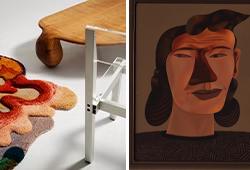Lena Cronqvist
"Patiens"
Signed Lena Cronqvist and dated 1975 verso. Oil on canvas 122 x 160 cm.
Provenance
Acquired from the artist.
Exhibitions
Galleri Doktor Glas, Stockholm, 1977.
Galerie Belle, Västerås, "Lena Cronqvist", 1980.
Museet Kulturhuset, Borås, "Museet Kulturhuset", 1981, kat nr. 37.
Liljevalchs konsthall, Stockholm, "Lena Cronqvist - retrospektiv", 1983.
Göteborgs konstmuseum, "Lena Cronqvist - retrospektiv", 1994.
Literature
Carl-Johan Bolander, Västerås, "Lena Cronqvist", 1979, illustrated full-page p. 85.
Galleri Lars Bohman, Stockholm, "Lena Cronqvist, Målningar, 1964-1994", 1994, illustrated full-page p. 93.
Mårten Castenfors m fl, "Lena Cronqvist", SAK 2003, ill. p. 63.
More information
The intence silence is so saturated that it borders on the ghostlike, reminiscent of Lena Cronqvist's work in the 1970s when she depicts the “Saloon (Salongen” and those who visit the room in a series of paintings. The setting is taken from the bourgeois home and she tells of the boredom of old age, using subdued colors and a large portion of gray in her palette. She depicts the stuffy, suffocating room where the transience of life trembles, where time was and is gone, and the present stands still. The figures are worn out and tired, their lives slowly ebbing away, and family gatherings are interruptions that function as breathing spaces in a world where life is on hold. The objects, those that have meant something to the owners for generations, become symbols of life that continues regardless of who uses the blue and white porcelain plates, the large dark cabinet, and the delicate crystal glasses. Between 1974-76, Cronqvist painted her parents and their closest ones. In just a few years, the party of life inevitably slows down and transforms into a heavy emptiness that pulsates against us, quietly demanding attention and providing insight into the unavoidable. The collections at the Gothenburg Art Museum house includes the work "Dinner with Strawberries, (Middag med jordgubbar)" painted in 1974. In the painting, the party is in full swing with toasts and intimate nods. The same year, "Dinner with Shrimp (Middag med räkor)" was created (Sundsvalls Museum), where plates overflow with pink crustaceans and white wine glistens elegantly in glasses. But appearances are deceiving, of course, and boredom lurks in the background.
In the current painting "Solitaire (Patiens)" from 1975, the voices have gone quiet. The couple sits alone, the table is empty and the high chairs, covered in burgundy velvet fabric, shut out the world and the life that goes on outside the window. "In these works where the subject is toned down, Cronqvist sharpens the contrast between emptiness and emotional disposition, between precise figuration and refined simplification, perhaps as an implied message to us viewers to identify with the situation using the objects as a starting point". During this time, Cronqvist finds her inspiration in the everyday life of her elderly parents. She is exploring herself and tackles subjects that many shy away from. The depicted silence in her family portraits of the 1970s is undoubtedly among her toughest, but also the foremost carriers of her brilliant way of interpreting and exploring the significant events in life. Determinedly, she seeks to capture her parents' daily life and their existence. She wants to know, to see the truth. The family photos from 1974-1980 are among Cronqvist's strongest. Ingela Lind writes in the book "Lena Cronqvist - The Painter" 1994; "One can see them as precursors to Lars Norén's psychodramas". "Solitaire (Patience)" is an artwork that touches so deeply into the soul that time seems to stand still.
Artist
Lena Cronqvist is born and raised in Karlstad. Her interest for the arts came early in her life, and she spent the first year of her studies in England, near Bristol’s Art School. Upon her arrival back in Sweden, Cronqvist began a short-lived education at Konstfack, leaving to study painting at the Royal Academy of Fine Arts. When examining Lena Cronqvist's painting, it delves into "painting" in its more traditional sense. She is indeed a painter in the grand modern tradition, frequently turning to Edvard Munch and Francis Bacon’s art as inspirational sources. Yet she also had numerous art historical references and a deep love for the craft. Cronqvist excelled as a colourist, finding harmony in the most unusual colour combinations – few have managed to paint warmth and cold successfully at the same time. Her subject matter is often perceived as challenging and overly private by many. She often models herself for her art, posing in mundane situations imbued with a sharp psychological character. Her “Modonna-pictures” from the 1970s are a good example of this. She turns our gaze away from the conventional, notably in her portrayal and depiction of girls, which is fascinating. Cronqvist depicts these girls as ugly, simple, and altogether uncomfortable – a great contrast to how woman were normally portrayed in art. In more recent years, Lena Cronqvist has studied the effect of aging, using herself as a study. Moreover, Cronqvist is a very successful sculptor, and several of her works in bronze have been sold great sums in the auction world. She is also gifted in graphic productions, of which “Strindbergsmappen” is the most well-known. Among her most renowned works is "The Betrothal," a paraphrase of Jan van Eyck's symbol-laden painting "The Arnolfini Portrait." In Cronqvist's reinterpretation, artist and husband Göran Tunström are the main characters, with equally weighty symbolism but carrying entirely different meanings. Where van Eyck's painting features a loyal dog, Cronqvist replaces it with a cat—a symbol of independence.
Read more






















































